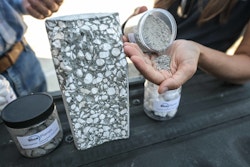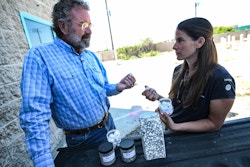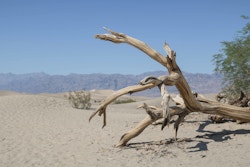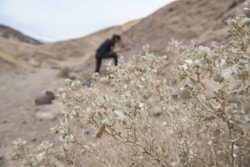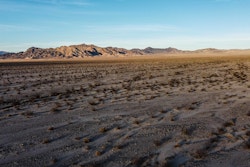Capturing carbon in the atmosphere: the solutions are in Nature
The rapid addition of carbon generated by human activities is warming the earth and changing our climate. Solutions to climate change are complex and multifaceted, but one way to mitigate climate change is right in front of us: trees and forests, by capturing carbon from the atmosphere, have an incredible potential to regulate the climate and restore natural habitats. Explanations with Dr Katia Nicolet, scientist and marine biologist on board Energy Observer.

General Sherman Tree, National Sequoia Park, California
A giant mess
Anthropogenic CO2 emissions - the amount of CO2 originated from human-activities - has reached 40 billion tonnes per year. 40,000,000,000 tonnes of excess carbon dumbed into our atmosphere every single year due to the burning of fossil fuel.
Today, this rapid addition of carbon is warming the earth and changing our climate. The world’s ecosystems are absorbing about half of our anthropogenic emissions, in forests and oceans, but not without dramatic consequences, like ocean acidification. This buffer provided by natural systems is all but running out. From 1900 to 2020, the atmospheric CO2 concentration went from 296 to 412 ppm (parts per million), resulting in an increase of 2˚C of global temperatures since the pre-industrial era. And the rate of warming has doubled in the past 40 years.
To give you an idea, the 10 warmest years on record have occurred since 2005, meaning that 10 out of the 15 past years have been the warmest in history...
“Our planet is warming, and it does so at an increasing speed.”
This is a mess humans have created. Not natural cycles of the sun, the earth or the stars, but us. Which means, it’s up to us to fix it too. Not only to restore our biosphere, but to insure our own survival.
The only meaningful way we can drastically reduce our emissions and reach net-zero emissions by 2050, is to transition away from fossil fuels and towards green, renewable and sustainable energies. But realistically, some industries will require more time than others to make the switch and will continue emitting large amounts of CO2 into our atmosphere for years to come.
In the meantime, we need mitigation strategies such as carbon capture: the sequestration of excess atmospheric carbon into solid or liquid form.
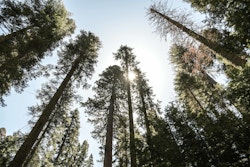
National Sequoia Park in California
Trees and forests, at the core of carbon capture
According to the Intergovernmental Panel on Climate Change (IPCC), humanity needs to remove 730 billion tonnes of CO2 from the atmosphere by the end of this century to avert the worst effects of climate change.
Unsurprisingly, hundreds of new technologies are being tested: giant ventilators sucking CO2 from the air, complex chemical reactions to turn atmospheric carbon into solid or liquid, massive drills and machineries to inject said carbon into aquifers and deep earth layers. More resources being extracted from the soils, more material being processed in factories, more energy being used to reduce the pollution generated by previous energy usage.
In our race for bigger and better solutions, we have lost sight of the simple solution perfected by nature for billions of years: photosynthesis. Trees, more specifically, could be our best ally in the fight against climate change.
A recent study published in Nature Climate Change (figure 1) found that forests absorb a net 7.6 billion tonnes of CO2 a year, creating a sink for this carbon to be permanently removed from the air. Plants absorb CO2 from the air and turn it into sugar, the building blocks for their wood, leaves and roots. When vegetation dies, bacteria and fungi decompose the organic matter and release some of this CO2 back into the atmosphere. A portion of this carbon however, is sequestered into the soil and never gets released into the air. Together, land plants and soils hold about 2,500 billion tonnes of carbon – about three times more than is held today in the atmosphere.
Unfortunately, if the forest is cut or burnt (for agriculture, pastureland, urban development etc.), the carbon stored into the wood and the soil is released. Much of the primary forests around the world have been destroyed: an estimated 7.3 million hectares of forests are lost every year according to the United Nations’ Food and Agriculture Organization. In the tropics, about half of the rainforests have already been cleaned, so much so that entire ecosystems are becoming source rather than sink of carbon.
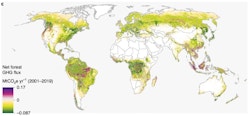
Figure 1: Net greenhouse gas (GHG) flux from forests in million tonnes of CO2 per year. Pink and purple colours mean the forest is a source of carbon, while yellow and green colours indicate a carbon sink.
Carbon sinks or carbon sources?
The world has three large tropical rainforests, which collectively are responsible for more carbon sequestration than temperate or boreal forests. These are located in the Amazon, the Congo River Basin and in Southeast Asia. Today, only the Congo forests is a strong net carbon sink (sequesters 600 million tonnes CO2 a year). For the past 20 years, the peaty rainforests of Southeast Asia have been a carbon source due to the clearing for plantations and the uncontrolled burns. And in recent news, the Amazon is on the brink of becoming a carbon source as well, after the heightened deforestation of the past four years.
Let it grow
But all is not lost yet, research published in Science in 2019 (figure 2) used satellite imagery to calculate the “global tree restoration potential” – the amount of land that could be restored into forests without damaging existing agricultural lands and cities. Excluding existing trees, they found that the earth could sustain an extra 0.9 billion hectares of forests: an area the size of the United States, which could store 205 billion tonnes of carbon. That would be enough to negate 20 years of human-produced carbon emissions at the current rate!
Another study in Nature (figure 3) found that previous calculations of carbon sequestration rates by young, growing forests were underestimated by over 30%! By using the previous default measures, governments might have been misjudging the benefits of natural forest regrowth and its potential as a climate solution.
Best part of it is, in many cases, no actions are directly required. Degraded habitats will grow back naturally if they are left alone, and these growing forests will harbour all the necessary native species for optimal ecosystem balance. All we need to do is protect existing forests and give degraded habitats the time and spaces they need for regeneration.
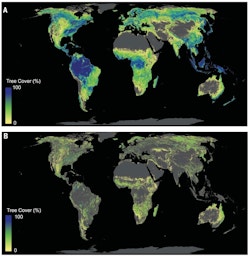
Figure 3: Global tree restoration potential. (A) The global potential tree cover including existing forests, representing an area of 4.4 billion hectares of canopy. (B) The global potential tree cover available for restoration, excluding existing forests, representing an area of 0.9 billion hectares.
Over their simple role of carbon capture, forests improve climate in many ways.
They soak water from the ground and release water vapour into the air. This phenomenon is called evapotranspiration and one large tree in the Amazon can release up to 1000 litres of water a day. Taken together, all the trees in the Amazon Forest deliver 30 trillion litres of water in the air every day, making the largest river not on land, but in the air! This flying river spreads from the Atlantic Ocean to the Andes and is regulating the climate and the precipitation levels of much of the South American continent. Without the Amazon and the billions of living water pumps, much of South America would be deserts, just like large parts of Australia in the same latitudes.
Climate is a living system, and forests are important living engineers of that system.
A natural treasure that cannot be priced
Despite the intuitive logic behind rewilding the earth and reforesting disrupted habitats, economists, scientists and governments are raising questions about the “economic value” and the “feasibility” of such undertaking.
To be clear, planting one essence of tree in a lot to harvest its wood for construction or introducing foreign “fast growing” trees to accelerate vegetation cover is not the same as reforesting and rewilding areas. A true restoration of a natural habitat will be different in every region and will require local knowledge about the specific flora and fauna. And while true reforestation is one of the best climate mitigation tools, planting trees will never be a substitute for eliminating fossil fuel emissions.
Nonetheless, questions around the cost-efficiency of restoring our earth’s natural habitats are nonsensical. Yes, we can do it, and of course we should do it. Humanity has lost sight of what is important for its own survival. We collectively spend billions of dollars to have a bigger house, a faster car, the newest smartphone, the latest fashion and –for the richest man on earth- the coolest travel to space. Yet, we are reluctant to invest in the one thing that keeps us alive: nature. Reforestation, regeneration and rewilding programs are often done by unpaid volunteers while IT engineers are well remunerated to design the next generation of smileys…
Nature, the climate, forests, oceans and all natural habitats are our life support systems. It’s time we invest our time, energy and money into keeping them healthy. Like our survival depended on it… because it does.
Sources
Global maps of twenty-first century forest carbon fluxes - Nature Climate Change
The global tree restoration potential - Science
Mapping carbon accumulation potential from global natural forest regrowth - Nature
